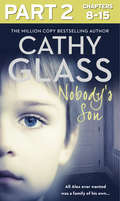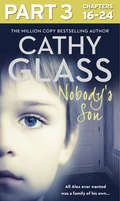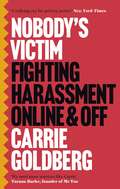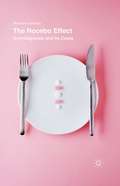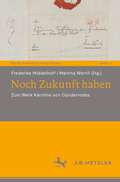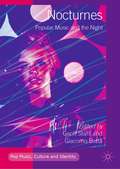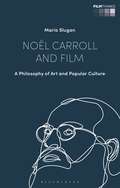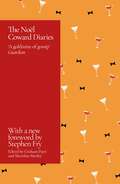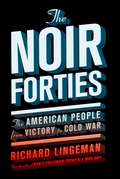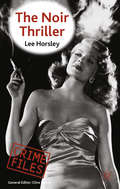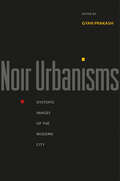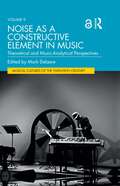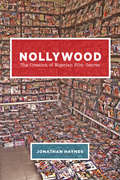- Table View
- List View
Nobody’s Son: All Alex Ever Wanted Was A Family Of His Own
by Cathy GlassBorn in a prison and removed from his drug-dependent mother, rejection is all that 7-year-old Alex knows.
Nobody’s Son: All Alex Ever Wanted Was A Family Of His Own
by Cathy GlassBorn in a prison and removed from his drug-dependent mother, rejection is all that 7-year-old Alex knows.
Nobody’s Victim: Fighting Psychos, Stalkers, Pervs, And Trolls
by Carrie Goldberg'A rallying cry for privacy justice . . . chilling . . . take-no-prisoners and warmly gregarious' New York Times 'We need more warriors like Carrie' Tarana Burke, founder of the MeToo movement 'In the age of doxxing, revenge porn, and misogynist trolls, this book is required reading. . . . In telling these wrenching stories, Goldberg gives voice to the legions who have experienced unthinkable violence' Esquire, Best Books of Summer 2019 Nobody's Victim is an unflinching look at a hidden world most people don't know exists-one of stalking, blackmail, and sexual violence, online and off-and the incredible story of how one lawyer, determined to fight back, turned her own hell into a revolution. Nobody's Victim invites readers to join Carrie Goldberg on the front lines of the war against sexual violence and privacy violations as her law firm sues the hell out of tech companies, schools, and sexual predators. Her battleground is the courtroom; her crusade is to transform clients from victims into warriors. In gripping detail, Carrie shares the diabolical ways her clients are attacked and how she, through her unique combination of relentless advocacy, badass risk-taking, and unique client-empowerment, pursues justice for them all. There is the ex-boyfriend who made fake bomb threats in a client's name, causing a national panic; the girl who was sexually assaulted on school grounds and then suspended when she reported the attack; and the guy who used a dating app to send more than 1,200 men to his ex's home and office for sex. Carrie also shares her own shattering story about why she began her work and became the lawyer she needed. Riveting and essential, Nobody's Victim is a bold and timely analysis of victim protection in the era of the Internet. This book is an urgent warning of a coming crisis, a predictor of imminent danger, and a weapon to take back control and protect ourselves-both online and off. *Perfect for fans of She Said by Jodi Kantor and Megan Twohey, The Whisper Network by Chandler Baker and The Good Fight*
The Nocebo Effect: Overdiagnosis and Its Costs
by Stewart JustmanThe Nocebo Effect documents the transformation of normal problems into medical ones and brings out the risks of this inflationary practice. One notable risk is that people labeled as sick may find themselves living up to their label through the alchemy of the nocebo effect.
Noch mehr Sand im Getriebe?: Kommunikations- und Interaktionsprozesse zwischen Landes- und Regionalplanung, Politik und Unternehmen der Gesteinsindustrie (RaumFragen: Stadt – Region – Landschaft)
by Karsten Berr Corinna Jenal Lara Koegst Olaf KühneObwohl mineralische Rohstoffe wie beispielsweise Kies, Sand, Quarz und Naturstein auf vielfältige Weise Grundlagen menschlicher Existenz ermöglichen und garantieren, haben Vorhaben zur Gewinnung mineralischer Rohstoffe vielerorts mit unterschiedlichen Akzeptanzproblemen zu kämpfen. Der planerische Umgang mit Rohstoffsicherung und Rohstoffgewinnung wurde wissenschaftlich bislang hauptsächlich in Bezug auf ökologische oder fachplanerische Problemstellungen, weniger hingegen als teilsystemischer Aspekt in einem soziopolitischen Kontext betrachtet, der durch verstärkten Bürgerprotest und erneuerte Partizipations- und Demokratisierungsbestrebungen gekennzeichnet ist.
Noch Zukunft haben: Zum Werk Karoline von Günderrodes (Neue Romantikforschung #5)
by Frederike Middelhoff Martina WernliDie literatur- und kulturwissenschaftliche Forschung zu Karoline von Günderrode (1780–1806) setzt seit gut zwei Jahrzehnten neue Akzente. Das Werk der Autorin wird in diesem Zuge als singulärer Beitrag zur Literatur-, Kultur- und Geistesgeschichte der Romantik profiliert, während der ‚Mythos Günderrode‘, der sich auf Leben, Lieben und vor allem Ableben der Autorin konzentriert, fundamental hinterfragt wird. Der vorliegende Band schließt an diese Re-Lektüren und neuen Perspektiven an. Er präsentiert wichtige Untersuchungen zu bislang wenig beleuchteten Facetten von Günderrodes Texten, die u.a. Poetologie, Ästhetik sowie ideengeschichtliche oder politische Aspekte umfassen, und legt zudem eine kommentierte Auswahl bislang kaum bekannter Briefe der Autorin in Transkription und Abbildung vor.
The Nocturnal City (Routledge Research in Culture, Space and Identity)
by Robert ShawNight is a foundational element of human and animal life on earth, but its interaction with the social world has undergone significant transformations during the era of globalization. As the economic activity of the ‘daytime’ city has advanced into the night, other uses of the night as a time for play, for sleep or for escaping oppression have come increasingly under threat. This book looks at the relationship between night and society in contemporary cities. It identifies that while theories of ‘planetary urbanization’ have traced the spatial spread of urban forms, the temporal expansion of urban capitalism has been less well mapped. It argues that, as a key part of planetary being, understanding what goes on at night in cities can add nuance to debates on planetary urbanization. A series of practices and spaces that we encounter in the night-time city are explored. These include: the maintenance and repair of infrastructure; the aesthetics of the urban night; nightlife and the night-time economy; the home at night; and the ecologies of the urban night. Taking these forward the book will ask whether the night can reveal some of the boundaries to what we call ‘the urban’ in a world of cities, and will call for a revitalized and enhanced ‘nightology’ to study these limits.
The Nocturnal City (Routledge Research in Culture, Space and Identity)
by Robert ShawNight is a foundational element of human and animal life on earth, but its interaction with the social world has undergone significant transformations during the era of globalization. As the economic activity of the ‘daytime’ city has advanced into the night, other uses of the night as a time for play, for sleep or for escaping oppression have come increasingly under threat. This book looks at the relationship between night and society in contemporary cities. It identifies that while theories of ‘planetary urbanization’ have traced the spatial spread of urban forms, the temporal expansion of urban capitalism has been less well mapped. It argues that, as a key part of planetary being, understanding what goes on at night in cities can add nuance to debates on planetary urbanization. A series of practices and spaces that we encounter in the night-time city are explored. These include: the maintenance and repair of infrastructure; the aesthetics of the urban night; nightlife and the night-time economy; the home at night; and the ecologies of the urban night. Taking these forward the book will ask whether the night can reveal some of the boundaries to what we call ‘the urban’ in a world of cities, and will call for a revitalized and enhanced ‘nightology’ to study these limits.
Nocturnes: Popular Music and the Night (Pop Music, Culture and Identity)
by Geoff Stahl Giacomo BottàThe night and popular music have long served to energise one another, such that they appear inextricably bound together as trope and topos. This history of reciprocity has produced a range of resonant and compelling imaginaries, conjured up through countless songs and spaces dedicated to musical life after dark. Nocturnes: Popular Music and the Night is one of the first volumes to examine the relationship between night and popular music. Its scope is interdisciplinary and geographically diverse. The contributors gathered here explore how the problems, promises, and paradoxes of the night and music play off of one another to produce spaces of solace and sanctuary as well as underpinning strategies designed to police, surveil and control movements and bodies. This edited collection is a welcome addition to debates and discussions about the cultures of the night and how popular music plays a continuing role in shaping them.
Noël Carroll and Film: A Philosophy of Art and Popular Culture (Film Thinks)
by Mario SluganNoel Carroll is one of the most prolific, widely-cited and distinguished philosophers of art, but how, specifically, has cinema impacted his thought? This book, one of the first in the acclaimed 'Film Thinks' series, argues that Carroll's background in both cinema and philosophy has been crucial to his overall theory of aesthetics. Often a controversial figure within film studies, as someone who has assertively contested the psychoanalytic, semiotic and Marxist cornerstones of the field, his allegiance to alternative philosophical traditions has similarly polarised his readership.Mario Slugan proposes that Carroll's defence of the notions of truth and objectivity provides a welcome antidote to 'anything goes' attitudes and postmodern scepticism towards art and popular culture, including film. Carroll's thinking has loosened the grip of continental philosophers on cinema studies - from Maurice Merleau-Ponty to Gilles Deleuze and Jacques Lacan - by turning to cognitive and analytical approaches. Slugan goes further to reveal that Carroll's methods of evaluation and interpretation in fact, usefully bridge gaps between these `opposing' sides, to look at artworks anew. Throughout, Slugan revisits and enriches Carroll's definitions of popular art, mass art, horror, humour and other topics and concludes by tracing their origins to this important thinker's relationship with the medium of cinema.
Noël Carroll and Film: A Philosophy of Art and Popular Culture (Film Thinks)
by Mario SluganNoel Carroll is one of the most prolific, widely-cited and distinguished philosophers of art, but how, specifically, has cinema impacted his thought? This book, one of the first in the acclaimed 'Film Thinks' series, argues that Carroll's background in both cinema and philosophy has been crucial to his overall theory of aesthetics. Often a controversial figure within film studies, as someone who has assertively contested the psychoanalytic, semiotic and Marxist cornerstones of the field, his allegiance to alternative philosophical traditions has similarly polarised his readership.Mario Slugan proposes that Carroll's defence of the notions of truth and objectivity provides a welcome antidote to 'anything goes' attitudes and postmodern scepticism towards art and popular culture, including film. Carroll's thinking has loosened the grip of continental philosophers on cinema studies - from Maurice Merleau-Ponty to Gilles Deleuze and Jacques Lacan - by turning to cognitive and analytical approaches. Slugan goes further to reveal that Carroll's methods of evaluation and interpretation in fact, usefully bridge gaps between these `opposing' sides, to look at artworks anew. Throughout, Slugan revisits and enriches Carroll's definitions of popular art, mass art, horror, humour and other topics and concludes by tracing their origins to this important thinker's relationship with the medium of cinema.
The Noel Coward Diaries: With a Foreword by Stephen Fry
by Sheridan Morley Graham Payn'A gold mine of gossip with a cast of thousands' GUARDIANThe unexpurgated diaries of one of the greatest, most talented, and wittily flamboyant characters of the 20th century - with a new introduction by Stephen Fry'Compulsive reading' SUNDAY TIMES'19th February 1956. A A Milne has died. Lord Beaverbrook has not ... Larry is going to make a movie of The Sleeping Prince with Marilyn Monroe, which might conceivably drive him round the bend''28th February 1960 Princess Margaret has announced her engagement to Tony Armstrong-Jones ... He looks quite pretty, but whether or not the marriage is entirely suitable remains to be seen.'Noel Coward was a renowned actor, dramatist, director - and star. His incredible zest, versatility and unrivalled wit are revealed in these diaries, with a cast of characters ranging from The Beatles to the Queen, Churchill to Marilyn Monroe.Touching, funny and revealing, THE NOEL COWARD DIARIES is a superb account of one of the greatest entertainers of all time.
The Noir Forties: The American People From Victory to Cold War
by Richard LingemanFrom one of our finest cultural historians, The Noir Forties is a vivid reexamination of America's postwar period, that "age of anxiety” characterized by the dissipation of victory dreams, the onset of the Red Scare, and a nascent resistance to the growing Cold War consensus. Richard Lingeman examines a brief but momentous and crowded time, the years between VJ Day and the beginning of the Korean War, describing how we got from there to here. It evokes the social and cultural milieu of the late forties, with the vicissitudes of the New Deal Left and Popular Front culture from the end of one hot war and the beginning of the cold one-and, longer term, of a cold war that preoccupied the United States for the next fifty years. It traces the attitudes, sentiments, hopes and fears, prejudices, behavior, and collective dreams and nightmares of the times, as reflected in the media, popular culture, political movements, opinion polls, and sociological and psychological studies of mass beliefs and behavior.
Noir, Now and Then: Film Noir Originals and Remakes (1944-1999) (Contributions to the Study of Popular Culture)
by Ronald SchwartzThis examniation of the cinematic style of film noir originals and their neo-noir remakes compares thirty-five films, beginning with Billy Wilder's classic Double Indemnity and concluding with Jim McBride's Breathless. In-depth analysis of the films explain the qualities and characteristics of film noir, while providing critical readings of both the originals and the remakes. The most significant films since 1944 are reviewed and reveal the ever-changing values in American society. As this study reveals, the noir style significantly impacted American film and neo-noir remakes attest to its continued popularity in cinematic art.This work will appeal to film scholars and to fans of film noir. Filmogrpahies and video information follow each chapter. Appendices briefly explain the roots of many noir films discussed in the text along with their subsequent remakes.
The Noir Thriller (Crime Files)
by Lee HorsleyWhat is literary noir? How do British and American noir thrillers relate to their historical contexts? In considering such questions, this study ranges over hundreds of novels, analysing the politics and poetics of noir from the hard-boiled fiction of Hammett, Chandler and Cain to the exciting diversity of nineties thrillers, with sections on the tough investigators, gangsters and victims of the Depression years: the first-person killers, femmes fatales and black protagonists of mid-century; the game-players, voyeurs and consumers of contemporary thrillers and future noir.
Noir Urbanisms: Dystopic Images of the Modern City
by Gyan PrakashDystopic imagery has figured prominently in modern depictions of the urban landscape. The city is often portrayed as a terrifying world of darkness, crisis, and catastrophe. Noir Urbanisms traces the history of the modern city through its critical representations in art, cinema, print journalism, literature, sociology, and architecture. It focuses on visual forms of dystopic representation--because the history of the modern city is inseparable from the production and circulation of images--and examines their strengths and limits as urban criticism. Contributors explore dystopic images of the modern city in Germany, Mexico, Japan, India, South Africa, China, and the United States. Their topics include Weimar representations of urban dystopia in Fritz Lang's 1927 film Metropolis; 1960s modernist architecture in Mexico City; Hollywood film noir of the 1940s and 1950s; the recurring fictional destruction of Tokyo in postwar Japan's sci-fi doom culture; the urban fringe in Bombay cinema; fictional explorations of urban dystopia in postapartheid Johannesburg; and Delhi's out-of-control and media-saturated urbanism in the 1980s and 1990s. What emerges in Noir Urbanisms is the unsettling and disorienting alchemy between dark representations and the modern urban experience. In addition to the editor, the contributors are David R. Ambaras, James Donald, Rubén Gallo, Anton Kaes, Ranjani Mazumdar, Jennifer Robinson, Mark Shiel, Ravi Sundaram, William M. Tsutsui, and Li Zhang.
Noir Urbanisms: Dystopic Images of the Modern City
by Gyan PrakashDystopic imagery has figured prominently in modern depictions of the urban landscape. The city is often portrayed as a terrifying world of darkness, crisis, and catastrophe. Noir Urbanisms traces the history of the modern city through its critical representations in art, cinema, print journalism, literature, sociology, and architecture. It focuses on visual forms of dystopic representation--because the history of the modern city is inseparable from the production and circulation of images--and examines their strengths and limits as urban criticism. Contributors explore dystopic images of the modern city in Germany, Mexico, Japan, India, South Africa, China, and the United States. Their topics include Weimar representations of urban dystopia in Fritz Lang's 1927 film Metropolis; 1960s modernist architecture in Mexico City; Hollywood film noir of the 1940s and 1950s; the recurring fictional destruction of Tokyo in postwar Japan's sci-fi doom culture; the urban fringe in Bombay cinema; fictional explorations of urban dystopia in postapartheid Johannesburg; and Delhi's out-of-control and media-saturated urbanism in the 1980s and 1990s. What emerges in Noir Urbanisms is the unsettling and disorienting alchemy between dark representations and the modern urban experience. In addition to the editor, the contributors are David R. Ambaras, James Donald, Rubén Gallo, Anton Kaes, Ranjani Mazumdar, Jennifer Robinson, Mark Shiel, Ravi Sundaram, William M. Tsutsui, and Li Zhang.
Noise as a Constructive Element in Music: Theoretical and Music-Analytical Perspectives (Musical Cultures of the Twentieth Century)
by Mark DelaereMusic and noise seem to be mutually exclusive. Music is generally considered as an ordered arrangement of sounds pleasing to the ear and noise as its opposite: chaotic, ugly, aggressive, sometimes even deafening. When presented in a musical context, noise can thus act as a tool to express resistance to predominant cultural values, to society or to socioeconomic structures (including those of the music industry). The oppositional stance confirms current notions of noise as something which is destructive, a belief not only cherished by hard-core rock bands but also shared by engineers and companies developing devices to suppress or reduce noise in our daily environment.In contrast to the common opinions on noise just described, this volume seeks to explore the constructive potential of noise in contemporary musical practices. Rather than viewing noise as a ‘defect’, this volume aims at studying its aesthetic and cultural potential.Within the noise music study field, most recent publications focus on subgenres such as psychedelic post-rock, industrial, hard-core punk, trash or rave, as they developed from rock and popular music. This book includes work on avant-garde music developed in the domain of classical music as well. In addition to already well-established (social) historical and aesthetical perspectives on noise and noise music, this volume offers contributions by music analysts.
Noise as a Constructive Element in Music: Theoretical and Music-Analytical Perspectives (Musical Cultures of the Twentieth Century)
by Mark DelaereMusic and noise seem to be mutually exclusive. Music is generally considered as an ordered arrangement of sounds pleasing to the ear and noise as its opposite: chaotic, ugly, aggressive, sometimes even deafening. When presented in a musical context, noise can thus act as a tool to express resistance to predominant cultural values, to society or to socioeconomic structures (including those of the music industry). The oppositional stance confirms current notions of noise as something which is destructive, a belief not only cherished by hard-core rock bands but also shared by engineers and companies developing devices to suppress or reduce noise in our daily environment.In contrast to the common opinions on noise just described, this volume seeks to explore the constructive potential of noise in contemporary musical practices. Rather than viewing noise as a ‘defect’, this volume aims at studying its aesthetic and cultural potential.Within the noise music study field, most recent publications focus on subgenres such as psychedelic post-rock, industrial, hard-core punk, trash or rave, as they developed from rock and popular music. This book includes work on avant-garde music developed in the domain of classical music as well. In addition to already well-established (social) historical and aesthetical perspectives on noise and noise music, this volume offers contributions by music analysts.
Noise - Klang zwischen Musik und Lärm: Zu einer Praxeologie des Auditiven (Kulturen der Gesellschaft #27)
by Kai GinkelWann wird Klang zur Musik, wann wird er als Lärm erfahren? Welche sozialen Praktiken stehen dahinter? »Noise«, eine Spielart der Klang- und Musikproduktion, die sich durch einen Fokus auf das Geräusch auszeichnet, ist prädestiniert dafür, musikalische Sinnstiftung zu untersuchen. Kai Ginkel ergründet diese, indem er Soziologie, Ethnografie und Sound Studies miteinander in Dialog bringt. Schwerpunkte seiner Studie sind Verkörperung, Raum, Konflikt sowie Wissen und Kompetenz.
Nollywood: The Creation of Nigerian Film Genres
by Jonathan HaynesNigeria’s Nollywood has rapidly grown into one of the world’s largest film industries, radically altering media environments across Africa and in the diaspora; it has also become one of African culture’s most powerful and consequential expressions, powerfully shaping how Africans see themselves and are seen by others. With this book, Jonathan Haynes provides an accessible and authoritative introduction to this vast industry and its film culture. Haynes describes the major Nigerian film genres and how they relate to Nigerian society—its values, desires, anxieties, and social tensions—as the country and its movies have developed together over the turbulent past two decades. As he shows, Nollywood is a form of popular culture; it produces a flood of stories, repeating the ones that mean the most to its broad audience. He interprets these generic stories and the cast of mythic figures within them: the long-suffering wives, the business tricksters, the Bible-wielding pastors, the kings in their traditional regalia, the glamorous young professionals, the emigrants stranded in New York or London, and all the rest. Based on more than twenty years of research, Haynes’s survey of Nollywood’s history and genres is unprecedented in scope, while his book also vividly describes landmark films, leading directors, and the complex character of this major branch of world cinema.
Nollywood: The Creation of Nigerian Film Genres
by Jonathan HaynesNigeria’s Nollywood has rapidly grown into one of the world’s largest film industries, radically altering media environments across Africa and in the diaspora; it has also become one of African culture’s most powerful and consequential expressions, powerfully shaping how Africans see themselves and are seen by others. With this book, Jonathan Haynes provides an accessible and authoritative introduction to this vast industry and its film culture. Haynes describes the major Nigerian film genres and how they relate to Nigerian society—its values, desires, anxieties, and social tensions—as the country and its movies have developed together over the turbulent past two decades. As he shows, Nollywood is a form of popular culture; it produces a flood of stories, repeating the ones that mean the most to its broad audience. He interprets these generic stories and the cast of mythic figures within them: the long-suffering wives, the business tricksters, the Bible-wielding pastors, the kings in their traditional regalia, the glamorous young professionals, the emigrants stranded in New York or London, and all the rest. Based on more than twenty years of research, Haynes’s survey of Nollywood’s history and genres is unprecedented in scope, while his book also vividly describes landmark films, leading directors, and the complex character of this major branch of world cinema.
Nollywood: The Creation of Nigerian Film Genres
by Jonathan HaynesNigeria’s Nollywood has rapidly grown into one of the world’s largest film industries, radically altering media environments across Africa and in the diaspora; it has also become one of African culture’s most powerful and consequential expressions, powerfully shaping how Africans see themselves and are seen by others. With this book, Jonathan Haynes provides an accessible and authoritative introduction to this vast industry and its film culture. Haynes describes the major Nigerian film genres and how they relate to Nigerian society—its values, desires, anxieties, and social tensions—as the country and its movies have developed together over the turbulent past two decades. As he shows, Nollywood is a form of popular culture; it produces a flood of stories, repeating the ones that mean the most to its broad audience. He interprets these generic stories and the cast of mythic figures within them: the long-suffering wives, the business tricksters, the Bible-wielding pastors, the kings in their traditional regalia, the glamorous young professionals, the emigrants stranded in New York or London, and all the rest. Based on more than twenty years of research, Haynes’s survey of Nollywood’s history and genres is unprecedented in scope, while his book also vividly describes landmark films, leading directors, and the complex character of this major branch of world cinema.
Nollywood: The Creation of Nigerian Film Genres
by Jonathan HaynesNigeria’s Nollywood has rapidly grown into one of the world’s largest film industries, radically altering media environments across Africa and in the diaspora; it has also become one of African culture’s most powerful and consequential expressions, powerfully shaping how Africans see themselves and are seen by others. With this book, Jonathan Haynes provides an accessible and authoritative introduction to this vast industry and its film culture. Haynes describes the major Nigerian film genres and how they relate to Nigerian society—its values, desires, anxieties, and social tensions—as the country and its movies have developed together over the turbulent past two decades. As he shows, Nollywood is a form of popular culture; it produces a flood of stories, repeating the ones that mean the most to its broad audience. He interprets these generic stories and the cast of mythic figures within them: the long-suffering wives, the business tricksters, the Bible-wielding pastors, the kings in their traditional regalia, the glamorous young professionals, the emigrants stranded in New York or London, and all the rest. Based on more than twenty years of research, Haynes’s survey of Nollywood’s history and genres is unprecedented in scope, while his book also vividly describes landmark films, leading directors, and the complex character of this major branch of world cinema.
Nollywood: The Creation of Nigerian Film Genres
by Jonathan HaynesNigeria’s Nollywood has rapidly grown into one of the world’s largest film industries, radically altering media environments across Africa and in the diaspora; it has also become one of African culture’s most powerful and consequential expressions, powerfully shaping how Africans see themselves and are seen by others. With this book, Jonathan Haynes provides an accessible and authoritative introduction to this vast industry and its film culture. Haynes describes the major Nigerian film genres and how they relate to Nigerian society—its values, desires, anxieties, and social tensions—as the country and its movies have developed together over the turbulent past two decades. As he shows, Nollywood is a form of popular culture; it produces a flood of stories, repeating the ones that mean the most to its broad audience. He interprets these generic stories and the cast of mythic figures within them: the long-suffering wives, the business tricksters, the Bible-wielding pastors, the kings in their traditional regalia, the glamorous young professionals, the emigrants stranded in New York or London, and all the rest. Based on more than twenty years of research, Haynes’s survey of Nollywood’s history and genres is unprecedented in scope, while his book also vividly describes landmark films, leading directors, and the complex character of this major branch of world cinema.
